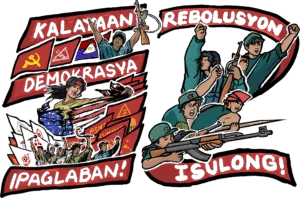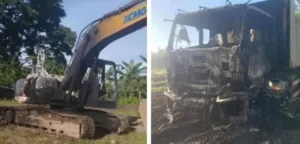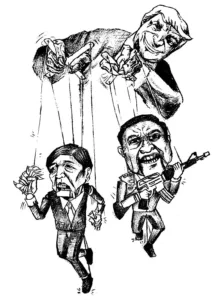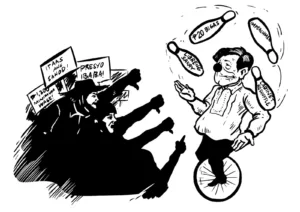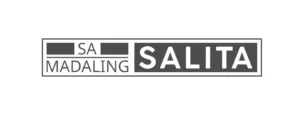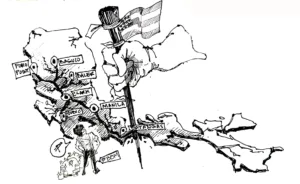By Julieta de Lima
Chairperson, International Network of Philippine Studies
Thank you for the opportunity to speak on a subject close to my heart: art and culture in revolution at the “Literature and Revolution Congress” with the th eme of “The Anticolonial Status of Mankind”. You have just heard Prof. Sison’s History of the Anticolonial and Anti-Imperialist Struggles; and People’s War in the Philippines. I shall now speak on how art and culture have been–if I may–choreographed into making such history.
Art and culture predate history and civilization as archaeologists have discovered. Primitive prehistoric humans left carvings and drawings that reflected not only visual primitive art but also a way of perceiving and understanding nature and themselves. These artistic artifacts reflect their activities and practice in gaining ever greater understanding of nature and their own possibilities. We can safely say that art and culture accompany all human activities and social existence in their struggle to understand themselves, nature and its laws.
With civilization classes and class struggles arose. In these class struggles, each class used art and culture to arouse, organize and mobilize its constituency to try to whelm the other class. And so is this reflected in the anticolonial, antifeudal and anti-imperialist struggles of the Filipino people and in the long history of the people’s war, which is the subject assigned to me.
Art and culture in the anti-imperialist struggles of the Filipino People.
The disparate rebellions carried out in different parts of the archipelago since Spanish colonial occupation matured into the First Propaganda Movement conducted by a rising bourgeoisie calling for integration of the Philippines as a province of Spain preceding the advent of the Katipunan revolutionary organization in 1896, which called for Philippine independence through armed struggle. Though led by the worker Andres Bonifacio, the Katipunan continued with its predecessor’s bourgeois liberal ideology. It recognized the importance of art and culture and continued these to conduct propaganda alongside the armed struggle and won the revolution in 1898.
In what we now call the Second Propaganda Movement, the precursors of the reestablished revolutionary party of the proletariat formed informal and voluntary discussion groups to study progressive liberal and Marxist-Leninist-Maoist literature. They discussed ideas that they could not find in formal classes in the university. Later, they formed university-based groups and associations and put up their cultural, literary and artistic instruments for their creative production of progressive propaganda literature (essays, poetry, and literary criticism).
By 1960, they organized the Student Cultural Association of the University of the Philippines (SCAUP) and expanded their propaganda vehicles to include frequent forums and symposiums in addition to the formal and informal discussion groups to attract more attendees and to increase their membership. These raised the political and ideological consciousness of SCAUP members and associates.
It had guest speakers from outside UP as well as progressive visiting foreigners. The subjects included the semifeudal and semicolonial domestic conditions, imperialism, socialism, the Cold War and other world developments that could not be found in the university curricula. These discussion groups predated the campus teach-ins popularized by the Students for a Democratic Society in the US from 1965 to 1968 to oppose the US war of aggression in Vietnam.
SCAUP’s initiatives served to break through the dominant climate of anti-communism flowing from the US McCarthyite witchhunt and the religious sectarianism of the feudal- patriarchal and comprador culture into the university and the country. It served as a university within the university. Its objective of continuing the unfinished Philippine revolution went beyond the UP confines and liberal parameters.
With the defeat and almost total silence of the old merger party of the communist and the socialist parties of Philippines in most of the 1950s, SCAUP picked up the call of Claro Mayo Recto, a progressive nationalist and anti-imperialist, for a second propaganda movement but went beyond his call for nationalism to adopt a socialist perspective.
SCAUP also formed regular clandestine groups to study such works as the Communist Manifesto, Dialectics of Nature, Materialism and Empirio-Criticism, “Wages, Price and Profit,” Mao’s Selected Works, “On Contradiction” and “On Practice.” Ideological work was very important because among the activists not a few were somehow influenced by aesthetic theories and works adhering to such currents as art for art’s sake, petty bourgeois self-titillation, mystical flights or art supposedly transcending classes but truly in the service of the exploiting classes.
SCAUP cooperated with other campus organizations, such as the UP Journalism Club, the Philippine Collegian, the UP Writers’ Club and the fraternities and sororities to promote its political line and advocacies, such as the fight against the anticommunist witchhunt undertaken by the Committee on Anti-Filipino Activities in 1959-61. SCAUP members associated with progressive elders in the faculty, extramural intellectuals and trade unionists.
They connected with trade unions and built contacts with student leaders to initiate student and youth groups and organizations in the other universities in Manila such as Far Eastern University, University of the East, Manuel L. Quezon University, Philippine College of Commerce, Lyceum of the Philippines and others.
By 1963, Progressive Publications was established to publish Progressive Review and educational pamphlets to influence the students, young professional’s and artists. Aside from these the progressive activists used campus publications and from time to time liberal publications such as the Philippines Free Press, Kislap-Graphic, etc. to which they submitted their literary and artistic works, press releases, statements and manifestos for publication. They consciously made friends and recruited established journalists and writers.
After Kabataang Makabayan (KM-Patriotic Youth) was established On November 30, 1964, the national-democratic movement quickly grew all over the country. Realizing the importance of art and culture in the struggle, KM formed its cultural bureau to organize writers and artists of all disciplines, including directors, composers and performing artists.
The KM systematized and conducted cultural work consistently. More groups were formed. Social investigation and mass integration teams doubled as cultural teams to perform in factories, urban and rural communities, college and high school campuses where more performers were recruited and organized to popularize revolutionary songs and other art forms.
Doing propaganda and cultural work among the masses necessitated the use of the national language or the regional lingua franca. Propaganda and other educational materials were translated into Tagalog and other major Philippine languages. English continued to be used for Progressive Review and other publications, including the book Struggle for National Democracy published in 1967 which veritably became the “bible” or basic text of the student and youth activists.
KM campaigned for the national language as the principal medium of education and literary development. University professors and instructors, high school teachers, and writers in English were encouraged to use, write, and conduct discussions in Pilipino. Tagalog and other local languages were used in the conduct of propaganda and agitation among the toiling masses.
The cultural and propaganda performing teams conducted systematic social investigation, mass integration, propaganda and organizing among the youth in urban and rural communities, in factories and school campuses (including high school) targeted for organizing into KM chapters.
Aside from staging performances, they conducted discussion groups and meetings where urgent issues of the day were taken up, in addition to the educational materials they brought with them, consisting of the KM Constitution and Program and mimeographed parts of SND. The schools for national democracy were organized. They flourished during periods of militant mass actions, especially during the First Quarter Storm of 1970.
KM also stressed the importance of studying the works of great Marxist-Leninist-Maoist masters and other revolutionary literature among activists who were honed to conduct social investigation, integrate with the masses and put what they learn into practice, in the spirit of following Mao’s mass line of learning from the masses to be able to teach the masses. The October 24 movement was launched in 1967 to urge the students to engage in mass work among the rural and urban poor.
In their mass work, activists learned at first hand the concrete manifestations of the evils of US imperialism and their subservient domestic ruling classes of landlords and compradors; and the double exploitation and oppression these imposed on the toiling masses. They learned how to expose these evils, to imbibe the aspirations of the masses for a better life; and work out with them the tactics of fighting the manifestations of these evils in their localities. Thus they were able to produce propaganda, literature and art of social and revolutionary significance that easily resonated with the masses and inspired them to join the movement.
Reestablishment of the Revolutionary Party of the Proletariat
Towards the reestablishment of the revolutionary party in 1968, intensive ideological, political and organizational work were conducted. Aside from drafting and discussing basic documents, including the rectification document, “Rectify Errors and Rebuild the Party,” in preparation for the Congress of Reestablishment, revolutionary literary and artistic works were produced to inspire the masses.
Philippine Society and Revolution was written shortly after the Party reestablishment, presenting from the standpoint of Marxism-Leninism-Maoism the main strands of Philippine history, the basic problems of the Filipino people, the prevailing social structure and the strategy and tactics and class logic of the people’s democratic revolution. First mimeographed in the last quarter of 1969, it was the main study material for the Party’s primary course but its circulation went well beyond the Party as this was published serially in the Philippine Collegian under the title Philippine Crisis and Revolution. Its first printed edition was published in the third quarter or 1970, followed by the first foreign edition published by Ta Kung Pao in Hong Kong.
With the founding of the CPP in 1968, cultural work became much more systematized. The cultural, the propaganda and the translation bureaus were organized under the Education Department. More cultural groups were organized in the regions, provinces and communities. NPA propaganda teams were dispatched to start social investigation, conduct mass work and build the mass base for guerrilla operations. Among the first groups they organized were those of cultural workers (painters, reciters of poems, actors, musicians, singers, dancers, etc.) especially among the youth and the women in the communities.
Pre-Martial Law and the FQS
Cultural work was well developed by the time the First Quarter Storm (FQS) broke out. Groups such as KM’sPanday Sining (Art Smithy), Samahang Demokratiko ng Kabataan’s (SDK – Democratic Youth Association) Gintong Silahis (Golden Ray) and the Philippine College of Commerce’s Kamanyang (Frankincense) did outstanding work among youth organizations in Manila and became models for youth and student cultural groups that proliferated in the provinces and regions.
Performance groups arose in the late 1960s to present solo and choral singing, instrumental music, poetry recitation, dances and skits and to create illustrations on publications, posters and walls in order to enliven and invigorate the meetings, mass protests and workers’ strikes.
Writers and artists organized themselves. Panulat para sa Kaunlaran ng Sambayanan (Pen for the prosperity of the People – PAKSA) was founded in 1971 by creative writers in Pilipino and English and other major Philippine languages, who were determined to serve the Filipino people.
Fine Arts and Architecture students and young professionals from UP and other universities founded the Nagkakaisang Progresibong mga Artista at Arkitekto (United Progressive Artists and Architects-NPAA) also in 1971. Most of them were members either of SCAUP or KM and had been very much involved in propaganda work in either of these organizations.
Many creative writers and artists joined the underground and armed revolutionary movement and created more works about the dire social conditions, the sacrifices and the struggles of the Filipino people. Literature and art flourished most among the NPA propaganda and cultural teams with the masses in the countryside. The central and regional publications of the CPP, NPA, and NDF published songs, poems, short stories and illustrations. Cultural organizations published, performed or exhibited the literary and artistic works of their members.
Songs, poetry recitations and educational lectures were popularized through audio cassette recorders and players. Revolutionary songs were recorded and reproduced for distribution to the provinces and regions for popularization. They were performed in celebrations and community gatherings in urban and rural communities. Primary and elementary school children sang them while at play.
Martial Law: from 1972 until the fall of Marcos in 1986
When martial law was proclaimed, artists and creative writers joined the underground and became Red fighters and at the same time practiced their craft. Their works were published in the revolutionary publications. Many writers and artists were abducted and tortured, became martyrs, and many more were imprisoned.
Fascist repression took a toll as Party cadres and members were captured and imprisoned. But it was futile for the fascist regime to detain them. Neither prison walls nor barbed wire fences could silence them. In prison, they reflected on their experiences, maintaining their strong ideological viewpoint and political standpoint, nurturing and polishing their craft with even more revolutionary fervor and relevance.
Arts and crafts flourished and flowed out of prisons to celebrate and inspire the struggling masses in songs, poetry, paintings, drawings, carvings, and myriads of handicrafts from materials that could be found in prison. Though they lost grip of the gun, the imprisoned cultural activists firmly grasped the pen to inspire their comrades and friends outside wielding both gun and pen as artistic and cultural work also flourished among them.
Prisons all over the country became crucibles of artistic creations, especially because despite the deprivations, these were venues for reflection (even for those in isolation cells) and for continuous regular revolutionary education. Outstanding songs, poems, paintings, drawings, carvings, pins, cards, handicrafts and others streamed out of prisons. They could be brought outside in various open and clandestine ways; and were sold and circulated far and wide to help boost the spirit of antifascist and anti-imperialist international solidarity among solidarity groups in Europe, North America and other continents.
Outstanding songs created in prison found their way out into the public, were sung at mass gatherings and demonstrations and reached the countryside and the guerrilla zones. Political detainees in various detention camps wrote and performed plays on the struggles of the workers, peasant and urban poor likewise reached the countryside and the guerrilla zones also to be performed there by the masses and the Red fighters.
Despite intense repression, cultural and propaganda groups and cultural work proliferated. Elaborate stage presentations and socially relevant mainstream movies were produced. Many won national and international awards. Graphic and visual artists organized Kaisahan (Unity) in 1976, which defined the artists’ role in society and produced works depicting the oppression and exploitation of workers, peasant and urban poor by imperialism, feudalism and bureaucrat capitalism.
Cultural groups and organizations burgeoned and their various productions increased. Anniversaries of the Party, NPA and NDF were celebrated with much cultural fanfare. Revolutionary songs and poems were recorded in cassette tapes and distributed to the regions and provinces for popularization such that one would know the guerrilla areas by hearing children singing them.
Anthologies of literary works and songs were published in the Philippines and abroad, under the direction of the Party’s National Commission on Culture. The Instityut sa Panitikan at Sining ng Sambayanan (Institute for the People’s Literature and Art – IPASA) published Akdang Pandigmang Bayan (Works for the People’s War),Ulos (Spear), and Dare to Struggle, Dare to Win (1973); Hulagpos (Break Free -1981); Mga Tula ng Rebolusyong Pilipino 1972-80 (Poems of the Philippine Revolution 1972-80); and more. Revolutionary literary works circulated among the people in urban and rural areas.
Lightning cultural performances were held even in city centers. Protest graffiti, periodikits and sticker-posters of various sizes could be found on walls, waiting sheds, and inside buses and jeepneys. A collective of creative writers and illustrators were able to produce the illustrated version of Philippine Society and Revolution in Tagalog translation. Prison & Beyond was published in 1985 and won the Manila Writers’ Award and later the Southeast Asian Write Award.
T-shirts with slogans and creatively designed placards and streamers, to huge murals and paper mache effigies were displayed at big marches and rallies. Protest music and street theater became widespread and popular through many small musical and theater groups based in unions, urban poor communities and schools. The resurgence of progressive and revolutionary art in the urban areas ran parallel to the constantly rising artistic and other cultural activities in the countryside.
To this day, the richest sources of literary and artistic works of revolutionary writers and artists are the central and regional publications and literary journals of the CPP, the NPA and the NDF. They publish songs, poems, short stories, illustrations and comic strips, aside from disseminating news and information about the revolutionary forces and the people in their respective areas.
An outstanding achievement of Filipinos abroad and the Philippine international solidarity movement was the Permanent Peoples’ Tribunal Session on the Philippines from October 30 to November 1, 1980. It found the fascist dictator Marcos guilty of grave and numerous economic and political crimes against the people in the Philippines and declare him unfit to govern, and subject to severe punishment for his past wrongs. It also condemned the US government for its role in sustaining, supporting and encouraging Marcos to act o of its own economic and global strategic interests.
The CPP and the national democratic movement in both urban and rural areas gained momentum and grew in size and strength during the pre-martial law and martial law rule of Marcos, despite the counterinsurgency strategy using the triad concepts of intelligence, psywar and combat operations under the AFP Oplan Katatagan (Stability).
Marcos’ assassination of Aquino led to an upsurge in the antifascist struggle that before long convinced the US policy makers to drop Marcos, encourage a fraction of the military to organize themselves into the Reform the Armed Forces Movement (RAM) against Marcos and support the anti-Marcos reactionaries to try to drive a wedge between the rapidly growing alliance between anti-Marcos reactionaries and the revolutionary forces. Marcos followed the US call for a snap election.
The US-supported opposition candidate was Aquino’s widow, Corazon Cojuangco Aquino, who since 1983 after her husband’s assassination had been working closely with the revolutionary mass movement. Unfortunately the CPP made a tactical error by calling for an election boycott on the ground that Marcos would stack the cards and win the elections anyway.
Thus progressive mass movement or advanced section of the broad masses missed an opportunity to take advantage of the anti-Marcos electoral campaign as venue for reaching the greater number of the masses to raise popular consciousness from the usual politicking issues to more fundamental issues affecting people’s lives and to raise their struggle to the level of necessary reforms against the US imperialists and the worst among local exploiting classes of compradors, landlords and bureaucrat capitalists that had further enriched themselves through landgrabbing and corruption with Marcos in power.
Indeed Marcos won the elections by using sheer fraud and intimidation. But this further outraged the people that again they took to the streets in hundreds of thousands. RAM took this as a signal and attempted a coup against Marcos. However, this was foiled by the Marcos loyalists in the military. Fortunately for the RAM, the mass movement combining with the Catholic Bishops Conference of the Philippines (Church) led by Jaime Cardinal Sin and the Aquino supporters came to their rescue in the EDSA Uprising that led more of the military to abandon Marcos. Finally the Marcos fascist dictatorship fell.
Marcos’ fall catapulted Corazon Aquino to the presidency. She declared a revolutionary government and made good on her promise to release all political prisoners. The goodwill built through the united front with the anti-Marcos reactionaries during the anti-Marcos struggle lasted for a while but did not last long as Aquino remained in the clutches of the US and the military. Progressives she appointed to the cabinet were later removed or forced to resign.
Repression returned with the Mendiola massacre of peasants and their urban supporters on January 22, 1987 and by February Aquino unsheathing the sword of war. Behind the bourgeois constitutional processes, militarization and repression of the basic masses and the progressive forces intensified. Massacres, assassinations (attempted and successful) and all sorts of state atrocities occurred under the regime’s Oplan Lambat-Bitag I and II.
These campaigns did some damage to the revolutionary movement but did not break it, despite the fact that these coincided with the growth of internal ideological, political and organizational errors, which ironically resulted from the successes in the revolutionary armed struggle, but induced erroneous notions of quick victory deviating from the strategic line of the people’s democratic revolution through protracted people’s war, of building strength in the countryside to surround the cities before the strategic offensive to seize the cities.
Succeeding Regimes after Aquino’s
The succeeding regimes of Ramos, Estrada, Arroyo and Aquino’s son were not much different. Ramos revived the negotiations for peace with the National Democratic Front representing the revolutionary forces. The negotiations completed the first substantive agenda, with the two panels signing of the Comprehensive Agreement on Respect for Human Rights and International Humanitarian Law (CARHRIHL).
Notwithstanding the negotiations, Ramos continued his regime’s “counterinsurgency” campaigns, Oplan Bantay Laya III and IV. However, the NDFP and the revolutionary forces competently handled the propaganda and educational aspects of the peace negotiations and continued to wage tit-for-tat struggles to counter every attempt of the reactionaries and the military to undermine and violate the agreements reached.
The start of the Ramos administration coincided with the start of the Party rectification movement. The significant losses in some parts of Party work-–ranging from the Party itself to the people’s army, the united front and the mass movement, drove the leadership to reassess their experience and identify the reasons for the revolutionary movement to fall into such a threatening situation. They held the 10th Plenum which decided to conduct the Second Great Rectification Movement (SGRM) in all aspects of the Party’s work.
The rectification documents, “Reaffirm Our Basic Principles and Rectify Errors,” “Stand for Socialism against Modern Revisionism” and “General Review of Important Events and Decisions (1980 to 1991)” were issued and distributed for study by the entire Party membership in a massive education movement conducted to reaffirm the CPP’s ideological, political line and organizational line.
The revolutionary forces worked hard in the recovery efforts and overcame the series of deceptively named “counterinsurgency” plans of successive post-Marcos presidents after Aquino’s Lambat Bitag (Net Trap) I and II under Aquino; III, IV and Pagkalinga (Nurture) under President Ramos; Oplan Makabayan (Patriotic) under Estrada; Oplan Enduring Freedom (Bush’ so-called anti-terrorism plan) adopted by Arroyo; Oplan Bayanihan (Mutual Cooperation) by Aquino II; and now Oplans Kapayapaan and Kapanatagan under Duterte.
Three more International People’s Tribunals were held: the Permanent Peoples’ Tribunal second session on the Philippines held The Hague, The Netherlands brought against President Arroyo and US President George W. Bush on March 21-25, 2007 http://permanentpeoplestribunal.org/second-session-on-the-philippines-repression-and-resistance/); the International Peoples’ Tribunal held in Washington DC on July 16-18, 2015 brought against President Aquino and US President Obama (https://internationalpeoplestribunal.org/); and the International Peoples’ Tribunal held in Brussels, Belgium on September 18-20 brought against President Duterte and US President Trump (https://humanrightsphilippines.net/events/international-peoples-tribunal-2018/).
Generally propaganda and protest art thrived from 1992 to 2016, with rich revolutionary substance and variety. An abundance of books of poetry and short story collections, conferences and assembly proceedings, commemorative volumes of major and minor national and regional organizations were published. This particular period is very well documented in books, pamphlets, videos, internet blogs, and other media.
Altermidya <http://altermidya.net/> (People’s Alternative Media Network) which describes itself as a network of independent and progressive media outfits, institutions and individuals was established in 2014. It conducts regular newscasts, commentaries on issues and media production training among mass activists and mass organizations. Tudla Productions <http://tudlaproductions.org/>, a multimedia production outfit has been reactivated since 2011 to produce progressive and revolutionary videos reporting on current issues and cultural activities among the masses.
Mass demonstrations, though not as large as those during the Marcos fascist regime and Aquino I regime were enlivened with placards, tarpaulin, streamers, t-shirts, and elaborate effigies. Movies, documentaries and theatrical productions were made on the history and activities of the revolutionary forces, including the protection of the environment, work with the indigenous communities, the US war of aggression on the Philippines in 1899, on the Philippine society and revolution to mark the NDF 30th anniversary, etc.
5. The Current Regime
A major victory of the revolutionary movement in this period was the holding of Party Congress in the 4thquarter of 2016, which was ceremonially capped with the celebration of the 100th anniversary of the victory of the Great October Socialist Revolution in Russia.
Party cadres and members representing the regional committees, staff organs and departments assembled to strengthen the Party’s unity, amend its program and constitution based on accumulated victories and lessons; and elect a new set of leaders. The theme “Greater unity, greater victories,” guided the Congress in reviewing the Party’s 48-year history, taking stock of the current objective and subjective conditions and reaffirming the Party’s determination to advance the national democratic revolution to greater heights.
With renewed vigor, the Party is entirely capable of confronting the challenges posed by the US-Duterte fascist-terrorist regime. It is already well on the way to completely frustrating the regime’s Oplans Kapayapaan and Kapanatagan whose objective is to destroy the revolutionary movement through violence and deception. The deadline for destroying the revolutionary moved has been moved from the end of 2018 to the middle of 2019 and further on to 2022. Having survived and prevailed over so many failed US-instigated and supported Oplans from Marcos’ down to Aquino II, the Party and the people are confident and certain that Duterte’s Oplans would fail miserably and the national democratic movement would grow in strength and move closer to victory.
The real intent of Duterte’s feint at peace negotiations has been exposed as a mere maneuver to advance his desperate wish to gain absolute power through the imposition of a fascist dictatorship with him as dictator for the rest of his life, and perpetuated through his children for them to continue grabbing wealth through fraud and bureaucratic corruption.
The underground revolutionary forces and the legal mass movement are growing. New alliances are forming to intensify the struggle against the tyranny and state terrorism. A worldwide movement against Duterte tyranny is gradually gaining ground and needs solidarity from peoples all over the world. Organizations of Filipinos abroad are expanding and strengthening themselves in building a broad united front of solidarity organizations to expose, oppose and fight the Duterte terrorist regime.
Cultural workers and artists now must take up such protest themes as agrarian problems, foreign economic domination, export of cheap labor, exploitation of women and children, and ecological damage, while they express their aspirations for genuine freedom and combat the neoliberal attacks, including those on progressive Philippine culture.
Let me cite One Billion Rising (OBR – http://www.onebillionrising.org) as a successful and vibrant propaganda campaign worthy of emulation. It started as a movement of feminist gender identity politics but evolved to revolutionary politics by raising its demand to comprehensive anti-imperialist and anti-reactionary concerns.
Now its demand goes well beyond the struggle against violence against women and patriarchy to the advocacy of women’s rights, the protection and defense of indigenous lands and the rights of indigenous peoples, struggle against fascism and tyranny, discrimination and racism, environmental plunder and destruction, corporate greed, economic violence, poverty, state brutality and repression, war and militarism.
The evolution of OBR owes much to its dynamically creative Filipino international coordinator, Monique Wilson, indefatigable activist, theatre director, performer as actor and singer, campaigner, organizer. OBR choreographs the truth of the people’s struggles against the lies and falsifications of the monopoly capitalism and all its reactionary agents. It presents an excellent vehicle and opportunity for expanding and consolidating our artistic and cultural work. This means further organizing and educational efforts to deepen anti-imperialist and revolutionary commitment and militancy among the masses.
Exhortation
Let me conclude with an exhortation to artistic and cultural workers.
Let us train ourselves to understand and deal with facts and events, as these unfold in the real-world conditions experienced by the toiling masses. Let us not confine ourselves in ivory towers, honing our individual imaginations and crafts, away from the real world and the masses. Let us study current events, study history, immerse ourselves among the masses in their struggles, and in the course of our struggle develop, together with them the people’s culture and art based on concrete realities.
Let us all contribute our utmost to the peoples’ unified cultural offensive against imperialism, aware that its overwhelming dominance necessitates strong organizations with strong leaderships guided by the ideology, politics and methods of the party of the most advanced and most productive class in our society today.
Especially in this age of the internet and multimedia, let us also help build powerful alternative and counter media–-powerful in that they are able to support the people’s struggles and effectively amplify the people’s voice, and in turn find resonance in and draw concrete support from the masses in their millions and billions. It is not enough for us to compete on shallow grounds with the imperialists in such superficial terms such as trending hashtags, viral youtube views, and TV ratings. Let us avail of the electronic and digital media in our own revolutionary way.
More important to us are the long-term results, measured in the sustained growth by leaps and bounds of the anti-imperialist mass organizations and mass movement at the national and international levels. Let us help build many channels, flowing in one general direction. Many small rivulets of the people’s struggles eventually conjoining into one endless current of strength to swamp the cultural bastions of the enemy.
The essential task of progressive and revolutionary forces all over the world today is developing unity, cooperation and coordination of all peoples and raising their level of struggle in order to weaken and defeat imperialism and reaction, in particular against imperialist plunder and war led by US imperialism, the foremost terrorist power, towards building a society that is just, peaceful, prosperous and progressive.
Thank you!###
